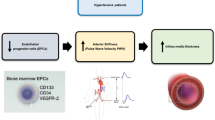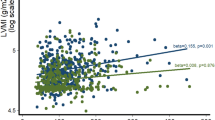Abstract
The objective of this study was to investigate the vascular status, left-ventricular mass and biomarkers of endothelial activation in hypertensive (HT) adolescents, with particular attention to comparing nonobese with obese patients. Seventy-nine newly diagnosed HT adolescents aged 15.1±2.1 years (divided into 34 nonobese and 45 obese) were compared with 35 healthy volunteers. Intima–media thickness (IMT), flow-mediated dilation (FMD) and left-ventricular mass index (LVMi) were determined using ultrasound. Adhesion molecules and inflammatory interleukins (ILs), together with lipids and insulin resistance (HOMA), were also studied. HT obese adolescents had higher triglycerides, HOMA, and elevated levels of interleukin-6, tumor necrosis factor-α, soluble intercellular adhesion molecule-1 and soluble E-selectin compared with controls and nonobese HT patients. FMD was lower in HT groups (8.5±4.5% in nonobese, P=0.004; 8.1±4.9%, P=0.01 in obese vs 12.5±4.9%; in control), and IMT was higher (0.52±0.06 mm, P<0.001 in nonobese; 0.54±0.05 mm, P<0.001 in obese vs 0.42±0.05 mm in control). Higher LVMi was found in both HT groups, with the highest value in the nonobese group being 37.8±5.3 g m−2.7 vs 28.4±5.3 g m−2.7 in controls (P=0.003). In conclusion, nonobese HT adolescents had the same early cardiovascular deteriorations assessed ultrasonographically as their obese HT peers, although metabolic alterations and endothelial activation measured as plasma biomarkers were more pronounced in obese individuals. The potential mechanisms of early atherosclerosis in nonobese HT adolescents need further evaluation in prospective studies because these factors may differ considerably from those found in young obese individuals with HT.
This is a preview of subscription content, access via your institution
Access options
Subscribe to this journal
Receive 12 digital issues and online access to articles
$119.00 per year
only $9.92 per issue
Buy this article
- Purchase on Springer Link
- Instant access to full article PDF
Prices may be subject to local taxes which are calculated during checkout

Similar content being viewed by others
References
Urbina EM, Williams RV, Alpert BS, Collins RT, Daniels SR, Hayman L et al. Noninvasive assessment of subclinical atherosclerosis in children and adolescents: recommendations for standard assessment for clinical research: a scientific statement from the American Heart Association. Hypertension 2009; 54: 919–950.
Rosamond W, Flegal K, Furie K, Go A, Greenlund K, Haase N et al. Heart disease and stroke statistics--2008 update: a report from the American Heart Association Statistics Committee and Stroke Statistics Subcommittee. Circulation 2008; 17: e25–146.
Bao W, Srinivasan SR, Wattigney WA, Berenson GS . Persistence of multiple cardiovascular risk clustering related to syndrome X from childhood to young adulthood. The Bogalusa Heart Study. Arch Intern Med 1994; 154: 1842–1847.
Bao W, Threefoot SA, Srinivasan SR, Berenson GS . Essential hypertension predicted by tracking of elevated blood pressure from childhood to adulthood: the Bogalusa Heart Study. Am J Hypertens 1995; 8: 657–665.
Aggoun Y, Farpour-Lambert NJ, Marchand LM, Golay E, Maggio AB, Beghetti M . Impaired endothelial and smooth muscle functions and arterial stiffness appear before puberty in obese children and are associated with elevated ambulatory blood pressure. Eur Heart J 2008; 29: 792–799.
Brady TM, Fivush B, Flynn JT, Parekh R . Ability of blood pressure to predict left ventricular hypertrophy in children with primary hypertension. J Pediatr 2008; 152: 73–78, e1.
Li S, Chen W, Srinivasan SR, Berenson GS . Childhood blood pressure as a predictor of arterial stiffness in young adults: The Bogalusa Heart Study. Hypertension 2004; 43: 541–546.
Hansen ML, Gunn PW, Kaelber DC . Underdiagnosis of hypertension in children and adolescents. JAMA 2007; 298: 874–879.
Balagopal PB, de Ferranti SD, Cook S, Daniels SR, Gidding SS, Hayman LL et al. Nontraditional risk factors and biomarkers for cardiovascular disease: mechanistic, research and clinical considerations for youth: a scientific statement from the American Heart Association. Circulation 2011; 123: 2749–2769.
Sorof J, Daniels S . Obesity hypertension in children: a problem of epidemic proportions. Hypertension 2002; 40: 441–447.
Raj M, Sundaram KR, Paul M, Sudhakar A, Kumar RK . Body mass index trend and its association with blood pressure distribution in children. J Hum Hypertens 2010; 24: 652–658.
Rahmouni K, Correia ML, Haynes WG, Mark AL . Obesity-associated hypertension: new insights into mechanisms. Hypertension 2005; 45: 9–14.
Glowinska-Olszewska B, Tolwinska J, Urban M . Relationship between endothelial dysfunction, carotid artery intima media thickness and circulating markers of vascular inflammation in obese hypertensive children and adolescents. J Pediatr Endocrinol Metab 2007; 20: 1125–1136.
Lande MB, Carson NL, Roy J, Meagher CC . Effects of childhood primary hypertension on carotid intima media thickness: a matched controlled study. Hypertension 2006; 48: 40–44.
Litwin M, Trelewicz J, Wawer Z, Antoniewicz J, Wierzbicka A, Rajszys P et al. Intima-media thickness and arterial elasticity in hypertensive children: controlled study. Pediatr Nephrol 2004; 19: 767–774.
National High Blood Pressure Education Program Working Group on High Blood Pressure in Children and Adolescents. The fourth report on the diagnosis, evaluation, and treatment of high blood pressure in children and adolescents. Pediatrics 2004; 114: 555–576.
Urbina EM, Alpert B, Flynn J, Hayman L, Harshfield GA, Jacobson M et al. Ambulatory Blood Pressure Monitoring in Children and Adolescents: Recommendations for Standard Assessment. A Scientific Statement From the American Heart Association Atherosclerosis, Hypertension, and Obesity in Youth Committee of the Council on Cardiovascular Disease in the Young and the Council for High Blood Pressure Research. Hypertension 2008; 52: 433–451.
Nawarycz T, Ostrowska-Nawarycz L . Body mass index in the school age children and youth from the city of Lodz. Pol Merkur Lekarski 2007; 23: 264–270.
Coretti MC, Anderson TJ, Benjamin EJ, Celermajer D, Charbonneau F, Creager MA et al. Guidelines for the ultrasound assessment of endothelial-dependent flow-mediated vasodilation of the brachial artery. J Am Coll Cardiol 2002; 39: 257–265.
Jourdan C, Wuhl E, Litwin M, Fahr K, Trelewicz J, Jobs K et al. Normative values for intima-media thickness and distensibility of large arteries in healthy adolescents. J Hypertens 2005; 23: 1707–1715.
Daniels SR, Kimball TR, Morrison JA, Khoury P, Meyer RA . Indexing left ventricular mass to account for differences in body size in children and adolescents without cardiovascular disease. Am J Cardiol 1995; 76: 699–701.
de Simone G, Devereux RB, Daniels SR, Koren MJ, Meyer RA, Laragh JH . Effect of growth on variability of left ventricular mass: assessment of allometric signals in adults and children and their capacity to predict cardiovascular risk. J Am Coll Cardiol 1995; 25: 1056–1062.
Burke GL, Evans GW, Riley WA, Sharrett AR, Howard G, Barnes RW et al. Arterial wall thickness is associated with prevalent cardiovascular disease in middle-aged adults. The Atherosclerosis Risk in Communities (ARIC) Study. Stroke 1995; 26: 386–391.
Krantz JS, Mack WJ, Hodis HN, Liu CR, Liu CH, Kaufman FR . Early onset of subclinical atherosclerosis in young persons with type 1 diabetes. J Pediatr 2004; 145: 452–457.
Lavrencic A, Kosmina B, Keber I, Videcnik V, Keber D . Carotid intima-media thickness in young patients with familial hypercholesterolaemia. Heart 1996; 76: 321–325.
Ayer JG, Harmer JA, Nakhla S, Xuan W, Ng MK, Raitakari OT et al. HDL-cholesterol, blood pressure, and asymmetric dimethylarginine are significantly associated with arterial wall thickness in children. Arterioscler Thromb Vasc Biol 2009; 29: 943–949.
Hanevold C, Waller J, Daniels S, Portman R, Sorof J . The effects of obesity, gender, and ethnic group on left ventricular hypertrophy and geometry in hypertensive children: a collaborative study of the International Pediatric Hypertension Association. Pediatrics 2004; 113: 328–333.
Litwin M, Niemirska A, Sladowska J, Antoniewicz J, Daszkowska J, Wierzbicka A et al. Left ventricular hypertrophy and arterial wall thickening in children with essential hypertension. Pediatr Nephrol 2006; 21: 811–819.
Meyer AA, Kundt G, Steiner M, Schuff-Werner P, Kienast W . Impaired flow-mediated vasodilation, carotid artery intima-media thickening, and elevated endothelial plasma markers in obese children: the impact of cardiovascular risk factors. Pediatrics 2006; 117: 1560–1567.
Kapiotis S, Holzer G, Schaller G, Haumer M, Widhalm H, Weghuber D et al. A proinflammatory state is detectable in obese children and is accompanied by functional and morphological vascular changes. Arterioscler Thromb Vasc Biol 2006; 26: 2541–2546.
Kampoli AM, Tousoulis D, Antoniades C, Siasos G, Stefanadis C . Biomarkers of premature atherosclerosis. Trends Mol Med 2009; 15: 323–332.
Ridker PM . High sensitivity C-reactive protein, inflammation and cardiovascular risk: from concept to clinical practice to clinical benefit. Am Heart J 2004; 148: S19–S26.
Reinehr T, Kiess W, de Sousa G, Stoffel-Wagner B, Wunsch R . Intima media thickness in childhood obesity: relations to inflammatory marker, glucose metabolism, and blood pressure. Metabolism 2006; 55: 113–118.
Akinci G, Akinci B, Coskun S, Bayindir P, Hekimsoy Z, Ozmen B . Evaluation of markers of inflammation, insulin resistance and endothelial dysfunction in children at risk for overweight. Hormones (Athens) 2008; 7: 156–162.
Glowinska B, Urban M, Koput A . Cardiovascular risk factors in children with obesity, hypertension and diabetes: lipoprotein (a) levels and body mass index correlate with family history of cardiovascular disease. Eur J Pediatr 2002; 161: 511–518.
Solini A, Santini E, Passaro A, Madec S, Ferrannini E . Family history of hypertension, anthropometric parameters and markers of early atherosclerosis in young healthy individuals. J Hum Hypertens 2009; 23: 801–807.
Falkner B, Lurbe E, Schaefer F . High blood pressure in children: clinical and health policy implications. J Clin Hypertens (Greenwich) 2010; 12: 261–276.
Gopinath B, Baur LA, Hardy LL, Kifley A, Rose KA, Wong TY et al. Relationship between a range of sedentary behaviours and blood pressure during early adolescence. J Hum Hypertens (e-pub ahead of print 26 May 2011; doi:10.1038/jhh.2011.40).
Assadi F . Effect of microalbuminuria lowering on regression of left ventricular hypertrophy in children and adolescents with essential hypertension. Pediatr Cardiol 2007; 28: 27–33.
Acknowledgements
This study was supported by the Polish State Committee for Scientific Research (grant number NN407144639).
Author information
Authors and Affiliations
Corresponding author
Ethics declarations
Competing interests
The authors declare no conflict of interest.
Rights and permissions
About this article
Cite this article
Głowińska-Olszewska, B., Tołwińska, J., Łuczyński, W. et al. Cardiovascular risk in nonobese hypertensive adolescents: a study based on plasma biomarkers and ultrasonographic assessment of early atherosclerosis. J Hum Hypertens 27, 191–196 (2013). https://doi.org/10.1038/jhh.2012.11
Received:
Revised:
Accepted:
Published:
Issue Date:
DOI: https://doi.org/10.1038/jhh.2012.11
Keywords
This article is cited by
-
Endothelial dysfunction as a factor leading to arterial hypertension
Pediatric Nephrology (2022)
-
Pediatric Hypertension: Impact on the Heart, Brain, Kidney, and Retina
Current Cardiovascular Risk Reports (2018)



